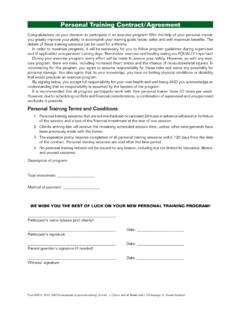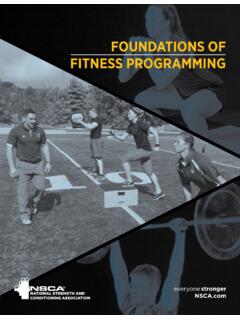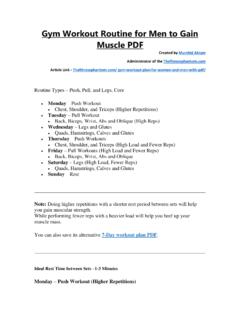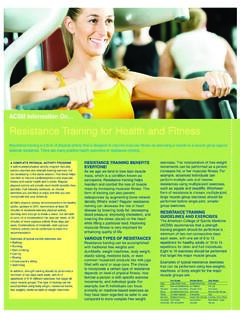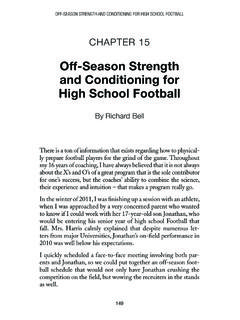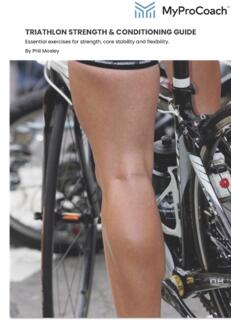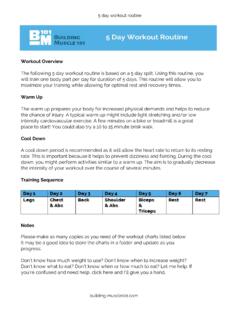Transcription of The National Strength and Conditioning Association’s …
1 The National Strength and Conditioning Association s (NSCA)BASICS OF Strength AND Conditioning MANUALDr. William A. Sands | Jacob J. Wurth | Dr. Jennifer K. HewitBasics of Strength and Conditioning1 Chapter 1 | Introduction 7 What is Expertise? 8 Increase Safety Awareness 8 Develop Your Abilities to Supervise Strength Training and Conditioning Activities 8An Overview of Strength Training and Conditioning 8 Principles of Training 9 Overview of Energy Systems 10 Conclusion 10 Chapter 2 | Program Design 13 How Do We Organize Training? 14 Training Design Terminology 14 Specific Adaptations to Imposed Demands (SAID Principle) 14 Annual Plan 14 Macrocycle 14 Mesocycle 14 Microcycle 14 Training Lesson 14 Program 14 Basics of Program Design Decisions 14 Training Load Prescriptions 15 Rules for Exercise Selection and Prescription 15 Warm-Up and Stretching 15 Components of a Warm-Up 16 Stretching During Warm-Up 17 Conclusion 17 Sample Strength and Conditioning 12-Week Program 19 Chapter 3 | Technique Fundamentals and Spotting 27 Technique Fundamentals 28 Handgrips 28 Grip Width 28 Stable Body and Limb Positioning 28 Range of Motion and Speed 28 Breathing Considerations 29 Lifting a Bar from the Floor 29 Spotting 29 Types of Exercises that Require Spotting 29 Spotting Overhead Exercises 29 Spotting over -the-Face Exercises 29 Spotting Considerations for Power Exercises 29 Number of Spotters 29
2 Communication Between Athlete and Spotter 29 Amount and Timing of Spotting Assistance 30 Spotting Techniques 30 barbell Bench Press - Spotting Technique 30 Dumbell Incline Bench Press - Spotting Technique 31 barbell Standing Behind the Neck Shoulder Press - Spotting Technique 31 barbell Back Squat - Spotting Technique with One Spotter 32 barbell Back Squat - Spotting Technique with Three Spotters 33 Chapter 4 | Exercise Technique 35 Explosive Lifting Day Outline 36 Strength Lifting Day Outline 36 Explosive Lifting Day Exercise Technique 361. Clean Progression 361a. barbell Rack Clean 361b. barbell Hang Clean 371c. barbell Power Clean 382. barbell High Pull 402a. High Pull from the Hang 403. Shoulder Progression 413a. Dumbbell Shoulder Raises 413b. barbell Standing Behind the Neck Shoulder Press 423c.
3 barbell Push Press 423d. barbell Push Jerk 434. Pulling Choice 444a. Pull-Ups 444b. Standing Low Row 44 Table of ContentsBasics of Strength and Conditioning24c. Lat Pulldown 454d. bent - over Row 455. Biceps Choice 465a. EZ-Bar Curl 466. Abdominals Choice 466a. Hand Planks 466b. Elbow Planks (front and sides) 47 Strength Lifting Day Exercise Description 481. Leg Progression 481a. barbell Back Squat 481b. barbell Front Squat 501c. barbell Clean Deadlift 512. barbell Romanian Deadlift 523. Single-Leg Choice 523a. Forward Step Lunge 523b. Walking Lunge 524. Pushing Progression 534a. barbell Bench Press 534b. barbell Incline Bench Press 544c. Dumbbell Bench Press 544d. Dumbbell Incline Bench Press 555. Triceps Choice 555a. Triceps Pushdown 556. Abdominals Choice 566a. Heel Touches 56 Conclusion 56 Chapter 5 | Speed and Agility Training 59 Introducing Plyometrics 60 Plyometrics 60 The Stretch-Shortening Cycle 60 Deceleration and Jump Training for Novice Athletes 61 Speed and Agility 61 Linear Speed 61 Agility 62 Interval Training 62 Components of Agility 62 Perceptual Decision-Making Factors 62 Technical Factors 62 Physical Factors 64 Anthropometric Factors 64 Agility Training Drills and Programming 64 Warm-up Drills 661.
4 High-Knees - 10 yards down and back 662. Heel-Ups 10 yards down and back 663. Forward Lunge with Elbow to Instep 10 yards 664. Side Lunge with Squat 4 each side 665. High Knee Foreleg Extension 10 yards down slow, 10 yards back quick 67 Speed Drills 681. Build-Ups 40 yards 682. Form Starts 683. Position Starts 684. Flying 10s 695. Power Skips (for height) 696. Power Skips (for distance) 697. Flying 20s 708. Harness Routine 709. Flying 30s 7010. Bag Jumps 7111. Hollow Sprints 71 Agility Drills 711. Rope or Ladder Routine 711a. Every Hole 711b. Every Other Hole 721c. Lateral Step 722. Bag Routine 722a. Change of Direction 722b. Shuffle 722c. Forward and Backpedal 733. Line Jump Routine 733a. Single Bunny Hop 733b. Double Bunny Hop 733c. Scissors 743d. Ali Shuffle 744.
5 Pro-Agility 745. Nebraska Agility 746. Three-Cone Drill 757. Four-Corner Drill 758. Sprint Ladder 76 Basics of Strength and Conditioning39. Shuffle Ladder 7610. Backpedal Ladder 77 Landing Drills 771. Drop Jump 772. Vertical Jump 783. Tuck Jump 784. 180 Degree Jump 785. Broad Jump with Vertical Jump 796. Depth Jump 807. Box Shuffle Step 808. Double Box Shuffle Step 809. Lateral Box Jump 81 Sample Program for Agility Drills - Weeks 5-12 85 Sample Program for Speed Drills - Weeks 7-12 89 Chapter 6 | Safe Training 93 Waivers and Informed Consent 94 Pre-Participation Screening and Clearance 94 Warnings 94 Supervision 95 Facility 96 Performance Safety Team 97 Preventing Sudden Death 97 Special Considerations 97 Sickle Cell Trait 97 Sudden Cardiac Death 98 Concussion 98 Exertional Rhabdomyolysis 98 Hyperthermia 99 Copyright 2012 by the National Strength and Conditioning Association.
6 All rights of Strength and Conditioning4 Performance PyramidBasics of Strength and Conditioning5 Dear NSCA Member:The National Strength and Conditioning Association (NSCA) is excited to provide you with this Basics of Strength and Conditioning Manual. This manual is intended to assist Associate Members, however, it is available to all NSCA Members to help them learn the basic principles and movement fundamentals that should be included in every Strength and Conditioning program. The first three levels of the Performance Pyramid covered in the Basics of Strength and Conditioning Manual will help prepare you to monitor or supervise Strength and Conditioning workouts. However, the NSCA highly recommends that any coach who wants to design or conduct an exercise program be CSCS top level of the Performance Pyramid is touched on briefly in the Basics of Strength and Conditioning Manual but to fully prepare for CSCS certification a coach would need to study the Essentials of Strength and Conditioning Text.
7 In addition, certified Strength coaches with two or more years experience can apply to be part of the NSCA s Registry of Strength and Conditioning Coaches (RSCC). Registered Strength and Conditioning coaches with 10 or more years of experience are classified by RSCC*D while RSCC*E indicates 20 or more years of experience and is the highest distinction a Strength coach can achieve in the industry. Please let us know if there is anything we can do for you as you move along the NSCA s Coaching Performance Path. More information can be found at you for your support of the National Strength and Conditioning Association, and we wish you the best in your coaching ,Boyd Epley, MEd, CSCS,*D, RSCC*E, FNSCANSCA FounderLetter From the FounderNSCA s Coaching Performance PathPerformance PyramidBasics of Strength and Conditioning7 CHAPTER ONE | INTRODUCTIONB asics of Strength and Conditioning8 Welcome to the National Strength and Conditioning Association s Basics of Strength and Conditioning Manual.
8 The NSCA is the worldwide authority on Strength and Conditioning and this manual was been developed to help you start your journey into the area of Strength training and Conditioning with some of the foremost coaches in the world. This manual is not meant to make you an expert, but rather to increase your knowledge, skills, and abilities with three goals in mind: Increase safety awareness Develop your abilities to supervise Strength training and Conditioning activities Provide an overview of the basic information needed to be effective as a Strength and Conditioning professionalWhat is Expertise?The time required to be an expert in any given area has been estimated at 10,000 hr, or approximately 10 years, of direct practice (3). This manual is for those interested in Strength training and Conditioning but are still in the formative stages, in other words you are not an expert.
9 Moreover, it is unlikely you will ever know everything there is to know about Strength training and Conditioning . A look at the number of variables involved in Strength training and Conditioning results in a list of about 50 ( , sets, reps, weight, exercise selection, technique, time of day, temperature, training status, etc.). We calculated the number of possible combinations of these variables and came up with a number so large that no one could possibly study and know all the combinations in a lifetime of effort. This means that Strength training and Conditioning involves such a vast area of knowledge that much of our job will be to reduce the number of things to know to a manageable level by emphasizing those that are the most important. The important things are the big ideas or big things.
10 It is vitally important that you get the big things right. The three objectives above, we believe, are the big things required for a basic understanding of Strength training and Safety AwarenessClearly, first we must commit to doing no harm as Strength training and Conditioning professionals. Like all athletic activities, injury is a possibility and we must prepare such that we reduce the likelihood of injury. We will cover safety, injury prevention, and risk management in the final chapter to ensure you leave this manual with safety foremost in your mind. Fortunately, injuries in Strength training and Conditioning are rare but constant vigilance and good judgment are always required (6,7,8). Risk management is a tactic that is used to reduce the likelihood of injuries along with the likelihood of legal problems that often accompany injuries.




